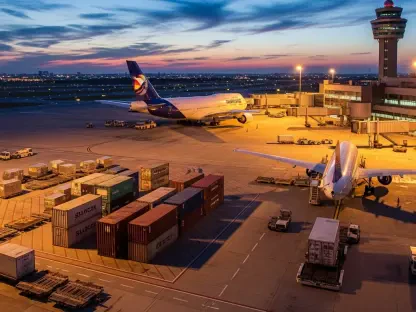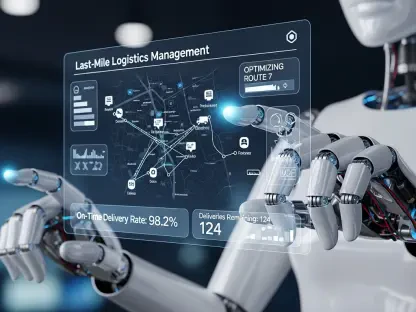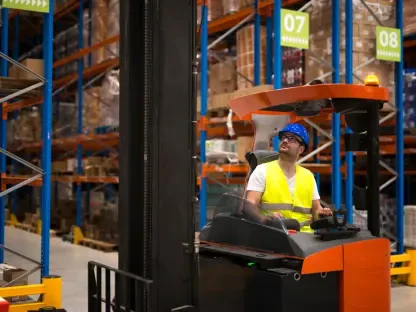The Rise of Automation in Amazon’s Operations
In an era where efficiency dictates market dominance, Amazon stands as a titan in e-commerce and logistics, employing millions globally and setting benchmarks for operational excellence while shaping how goods move from warehouses to doorsteps across America. As of this year, 2025, the company’s influence extends beyond mere retail, redefining speed and accessibility in shopping through its sprawling network of fulfillment centers, which has become a cornerstone of modern consumerism.
Central to this dominance is Amazon’s ambitious automation strategy, which aims to mechanize 75% of its U.S. warehouse and logistics operations within the next two years, by 2027. This plan signals a seismic shift, not just for the company but for the entire industry, as technology increasingly replaces manual labor. The push toward automation is driven by a need to meet soaring demand while slashing costs, positioning Amazon as a pioneer in integrating cutting-edge solutions into everyday operations.
This transformation underscores the broader trend of automation reshaping retail and logistics, with Amazon leading the charge through robotics and artificial intelligence (AI). Competitors such as Walmart and FedEx are also investing heavily in similar technologies, though Amazon’s scale and pace set it apart. The race to innovate is fueled by advancements in machine learning and robotic systems, creating a landscape where efficiency often overshadows traditional employment models, raising critical questions about the future of work.
Scale and Scope of Amazon’s Automation Push
Cutting-Edge Technologies and Implementation
Amazon’s automation efforts hinge on sophisticated robotics designed to handle a range of warehouse tasks with precision. Systems like Proteus, Sequoia, and Vulcan are at the forefront, managing everything from sorting packages to intricate packing processes that once relied on human hands. These machines are not mere tools but integral components of a streamlined operation, reducing errors and accelerating workflows in fulfillment centers.
Beyond robotics, AI-driven systems play a pivotal role in optimizing efficiency across sorting, packing, and even last-mile delivery. These technologies analyze vast datasets to predict demand, manage inventory, and route packages with minimal human intervention. As of 2025, Amazon already deploys over 750,000 robots worldwide, a number set to surge significantly by 2027, reflecting a relentless drive to scale technological integration across its global network.
The potential for expansion through these innovations offers Amazon opportunities to lower costs and enhance competitive pricing. As robots become more versatile and AI systems smarter, the company can adapt to fluctuating market needs with agility. This scalability ensures that automation is not just a short-term fix but a long-term strategy to maintain leadership in a cutthroat industry.
Financial and Market Impact
The financial incentives behind Amazon’s automation push are staggering, with projected cost savings of $12.6 billion over the next two years, from 2025 to 2027. This translates to a reduction of 30 cents per item processed, a seemingly small figure that accumulates into massive gains at Amazon’s scale. Such savings bolster the company’s ability to undercut competitors on price while maintaining robust profit margins.
Market data highlights how this operational efficiency strengthens Amazon’s grip on e-commerce, influencing pricing strategies across the sector. By minimizing labor costs, the company can offer faster shipping and lower prices, setting a standard that others struggle to match. This dynamic not only benefits consumers but also pressures rival firms to adopt similar technologies to stay relevant.
Looking ahead, forecasts suggest that Amazon’s automation will solidify its dominance in logistics, creating ripple effects on industry norms. The focus on cost reduction and speed could redefine consumer expectations, pushing smaller players out of the market. Financial motivations are clearly steering this agenda, reshaping market dynamics in favor of tech-driven giants over traditional labor-intensive models.
Challenges of Workforce Displacement
Amazon’s automation trajectory, while impressive, casts a shadow over its workforce, with projections estimating a loss of over 600,000 jobs by 2033. The replacement of repetitive tasks—such as lifting, sorting, and delivery—with machines threatens the livelihoods of many, particularly those in low- to mid-skill positions. This scale of displacement represents a profound challenge for employees who have relied on these roles for stability.
The impact is especially severe in rural and suburban communities where Amazon fulfillment centers serve as major economic pillars. In these areas, job losses could destabilize local economies, reducing purchasing power and affecting ancillary businesses like retail and services. The ripple effect of such cuts risks creating pockets of economic hardship, amplifying existing regional disparities.
Social challenges compound the issue, as workers grapple with anxiety over job security and face significant hurdles in transitioning to new roles. Many lack the skills or access to training needed for emerging tech-focused positions, creating a gap between current capabilities and future demands. Addressing this displacement will require targeted strategies, including comprehensive retraining programs and community support initiatives, to ease the burden on affected individuals and regions.
Regulatory and Ethical Considerations
Navigating the automation surge involves grappling with a complex regulatory landscape in the U.S., particularly around workplace safety and labor standards. As machines proliferate in warehouses, ensuring safe human-robot interactions becomes paramount, alongside compliance with existing labor laws. Regulators are increasingly scrutinizing how companies like Amazon balance technological adoption with worker protections.
Ethical concerns also loom large, especially regarding the mass displacement of workers and the responsibility corporations bear in such transitions. Replacing hundreds of thousands of jobs with robots raises questions about fairness and the societal cost of unchecked innovation. Stakeholders are calling for a framework that prioritizes human welfare alongside profit, urging companies to consider the broader implications of their strategies.
Potential policy responses could include government incentives for retraining or subsidies to support displaced workers, aiming to harmonize innovation with job preservation. Meanwhile, Amazon has sought to shape public perception by emphasizing terms like “cobots” for collaborative robots and investing in community projects. These efforts, while notable, must be matched by substantive action to address the ethical dilemmas and regulatory challenges posed by rapid automation.
Future of Work in an Automated Era
Amazon’s automation strategy offers a glimpse into the long-term implications for the labor market, hinting at a future where technology fundamentally alters industry trends. As repetitive tasks vanish, the demand for human labor in traditional roles is likely to shrink, reshaping career paths in retail and logistics. This shift challenges the very structure of employment as it has been understood for decades.
Competitors may accelerate their own automation efforts in response, fearing loss of market share to Amazon’s efficiency. Such a trend could lead to widespread job displacement across the sector, affecting millions beyond Amazon’s workforce. The cascading effect might transform retail and logistics into tech-heavy fields, prioritizing skills that many current workers do not possess.
While new roles in robotics maintenance and AI management are emerging, barriers to entry—such as education and cost—could exclude displaced workers from these opportunities. Global economic conditions, rapid technological advancements, and evolving consumer preferences will further influence labor dynamics, potentially widening the divide between tech-savvy professionals and those left behind. Navigating this transition will demand innovative solutions to ensure inclusivity in the automated era.
Conclusion: Balancing Innovation and Responsibility
Reflecting on Amazon’s automation journey, it becomes evident that the strategy is a double-edged sword, delivering unparalleled efficiency while jeopardizing countless livelihoods. The staggering projection of 600,000 job losses by 2033 underscores a critical tension between progress and human impact. This duality frames much of the discourse around the company’s role in reshaping industry standards.
Moving forward, stakeholders are urged to prioritize robust retraining programs and policy interventions to mitigate economic inequality. Governments and corporations alike need to collaborate on accessible education initiatives, ensuring displaced workers can pivot to emerging fields. Incentives for hiring in tech-adjacent roles also emerge as a potential bridge to lessen the transition’s harshness.
Ultimately, the broader implications for the American workforce point toward a reimagined labor market, one requiring adaptability and foresight. A concerted effort to build social support systems alongside technological advancement stands as a vital next step. Only through such balanced measures can innovation serve as a tool for collective growth rather than a source of division.









